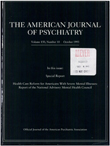Nonfearful panic disorder in neurology patients validated by lactate challenge
Abstract
OBJECTIVE: Nonfearful panic disorder meets the DSM-III-R criteria for panic disorder but is not associated with subjective fear and anxiety. The authors determined its prevalence in a group of neurology patients and assessed its diagnostic validity as a panic disorder subtype by evaluating the response of the patients with nonfearful panic disorder to sodium lactate and antipanic pharmacotherapy. METHOD: The subjects were all neurology patients referred over 1 year to a university hospital's psychiatric consultation service because of negative medical workups for their symptoms (N = 48). Patients who met the DSM-III-R criteria for panic disorder but did not report subjective anxiety or fear during panic episodes were diagnosed as having nonfearful panic disorder. Afterward, each of those patients received a sodium lactate infusion and, 5 hours later, a sodium chloride infusion. They were then treated with antipanic medication and followed for at least 6 months. RESULTS: Of the 48 neurology patients referred for psychiatric evaluation, 11 (23%) met the criteria for panic disorder, and all 11 met the criteria for nonfearful panic disorder. All 11 responded positively to lactate but not to placebo, and they each experienced an at least 75% reduction in symptoms during the 6-month follow-up period. Detailed case reports of three of these patients are presented. CONCLUSIONS: These findings support the construct and predictive diagnostic validity of nonfearful panic disorder as a subtype of panic disorder and suggest that a lack of attention to this group leads to both the underestimation of the prevalence of panic disorder and to the withholding of potentially successful treatments for this group.
Access content
To read the fulltext, please use one of the options below to sign in or purchase access.- Personal login
- Institutional Login
- Sign in via OpenAthens
- Register for access
-
Please login/register if you wish to pair your device and check access availability.
Not a subscriber?
PsychiatryOnline subscription options offer access to the DSM-5 library, books, journals, CME, and patient resources. This all-in-one virtual library provides psychiatrists and mental health professionals with key resources for diagnosis, treatment, research, and professional development.
Need more help? PsychiatryOnline Customer Service may be reached by emailing [email protected] or by calling 800-368-5777 (in the U.S.) or 703-907-7322 (outside the U.S.).



